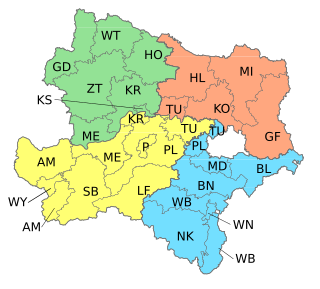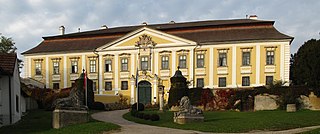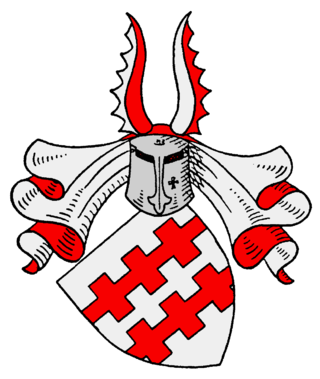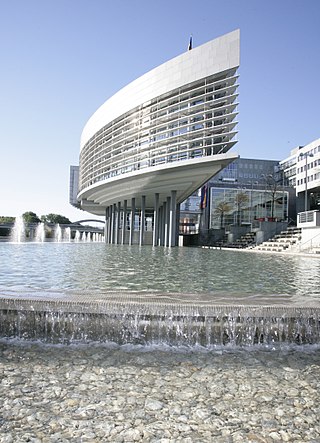
Austria is a predominantly mountainous country in Central Europe, approximately between Germany, Italy and Hungary. It has a total area of 83,871 square kilometres (32,383 sq mi).

Lower Austria is one of the nine states of Austria, located in the northeastern corner of the country. Since 1986, the capital of Lower Austria has been Sankt Pölten, replacing Vienna, which became a separate state in 1921. With a land area of 19,186 km2 (7,408 sq mi) and a population of 1.685 million people, Lower Austria is the second-most-populous state in Austria. Other large cities are Amstetten, Klosterneuburg, Krems an der Donau, Stockerau and Wiener Neustadt.

Laxenburg is a market town in the district of Mödling, in the Austrian state of Lower Austria. Located about 20 km (12 mi) south of the Austrian capital Vienna, it is chiefly known for the Laxenburg castles, which, beside Schönbrunn, served as the most important summer retreat of the Habsburg monarchs.

The Weinviertel or Viertel unter dem Manhartsberg is located in the northeast of Lower Austria.
Bezirk Gänserndorf is a district of the state of Lower Austria in Austria. The Marchfeld lies in it.

The ruins of Falkenstein Castle is in the Weinviertel region of Lower Austria, about 55 kilometres (34 mi) north of Vienna near the border to Czech Republic.

The Waldviertel is the northwestern region of the northeast Austrian state of Lower Austria. It is bounded to the south by the Danube, to the southwest by Upper Austria, to the northwest and the north by the Czech Republic and to the east by the Manhartsberg, which is the survey point dividing Waldviertel from Weinviertel. Geologically it is a part of the Bohemian Massif. In the south are the Wachau and Kamptal wine regions.

Herzogenburg Monastery is an Augustinian monastery located in Herzogenburg in Lower Austria. Founded in 1112 by Augustinian Canons, the monastery was refurbished in the Baroque style in 1714 by Jakob Prandtauer, Johann Bernhard Fischer von Erlach, and Josef Munggenast.

The Krems is a river in Waldviertel in northern Lower Austria. Its drainage basin is 366 km2 (141 sq mi). There are actually two rivers: the so-called "Große Krems", denoting either the whole river system or the main tributary only, and the smaller one called "Kleine Krems". The Krems originally flowed into the Danube by Krems an der Donau, but when the Danube power station Altenwörth was built at Altenwörth, the mouth of the river — together with that of the Kamp — was moved to Altenwörth.

Schloss Gobelsburg is a winery and castle in the Kamptal wine growing region in Lower Austria, some 50 miles to the north west of Vienna. The estate produces both red and white wines. Wine production on the estate dates to 1171; it is the oldest winery in the Danube region. The structure is a listed building.
The Dürre Wand is a mountain ridge in Lower Austria and belongs topographically to the Gutenstein Alps. It stretches from Miesenbach in a WSW direction to the Schneeberg. The Dürre Wand is a ridge, rocky in places, which is bordered by pastures, forests and waterfalls. In contrast to Hohe Wand plateau in the immediate east, it culminates in a narrow ridge-line with its hiking trail offering outstanding views.

Districtus Austriae Controllatus, DAC, is a classification for regionally typical quality wine in Austria. It is loosely modelled on the French Appellation d'Origine Contrôlée (AOC) system, and is coupled with a ripeness-based classification scale that shares a lot of nomenclature with the German Prädikat system. Thus, if a label states the winegrowing region followed by the letter combination “DAC” we are talking about a regionally typical quality wine. All Austrian quality wines have a round, red and white striped "Banderole" on the capsule, which ensures, that it has been inspected and approved by the government tasting authority and fulfills the requirements for “Qualitätswein”, such as maximum yields per hectare, minimum must weight and alcohol levels and guaranteed origin of the grapes.
Emil Erwin Alfred Ritter von Janchen-Michel was an Austrian botanist.

Together with the Hussars and Uhlans, the Imperial and Royal Dragoons made up the cavalry of the Austro-Hungarian Army from 1867 to 1914.

The Pranckh family is an ancient Austrian noble family, descending from Pranckh Castle, near Sankt Marein bei Knittelfeld in the former March and later Duchy of Styria. The family's origins date back to the year 1135, when Wolfkerus de Branka attested a charter regarding an endowment to Admont Abbey, thus making it one of the oldest families in Austria still present today. In addition to the Styrian mainline, other branches existed in Salzburg, Carinthia, Lower Austria and Bavaria. In later parts of history, the family rose from Knights to Reichsfreiherren (Barons of the Holy Roman Empire) and Reichsgrafen (Imperial Counts of the Holy Roman Empire). Many of their names can be found in high court and state offices of the Archbishopric of Salzburg. Branches of the family exist to this day in Austria, Germany, France and the United States.

Matthias Laurenz Gräff is an Austrian academic painter, private historian, politician, political activist and co-organizer of the non-partisan political and diplomatic platform Dialog im Kamptal. Since 2013 he acted as chairman of the worldwide Family Association Gräff-Graeff.

The Bucklige Welt is a region in southeast Lower Austria. It is also known as the "land of a thousand hills".

The Landtag of Lower Austria is the state parliament of the Austrian state of Lower Austria. It exercises the state legislation (legislature). The seat of the Landtag is in St. Pölten in the Landhausviertel.
Robert Streibel is an Austrian historian, writer and poet.

Johann Haselböck was an Austrian organist, composer, author and academic teacher. He was organist at the Dominican Church, Vienna, for 65 years, and was professor of organ and improvisation at the Vienna Music Academy, where he later also served as head of the faculty of church music and as deputy rector. He gave organ concerts in Europe, North America, and the Near and Far East. Haselböck is regarded as a pioneer of Catholic church music in the German language after the Second Vatican Council.
















